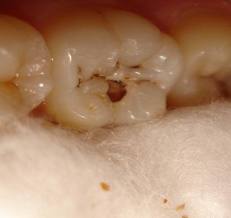Eruption is the axial movement of a tooth from its nonfunctional position in the bone to functional occlusion. However, eruption is often used to indicate the moment of emergence of the tooth into the oral cavity. The normal eruption of deciduous and permanent teeth into the oral cavity occurs over a broad chronologic age range. Racial, ethnic, sexual, and individual factors can influence eruption and are usually considered in determining the standards of normal eruption. True and significant deviations from accepted norms of eruption time are often observed in clinical practice. Premature eruption has been noted, but delayed tooth eruption (DTE) is the most commonly encountered deviation from normal eruption time. Continue reading
Category Archives: Baby Teeth
Eruption dates
Human beings have two sets of teeth —- Primary (milk teeth) and Permanent. There are 20 primary and 32 permanent teeth. In some people one or more teeth may be absent, or they may have some extra teeth (supernumerary). Usually the first primary teeth erupt by 6 months and the first permanent by 6 years of age. Children loose their milk teeth between 6 and 11 years of age. By the age of 13 years almost all the permanent teeth have erupted: 8 incisors, 4 canines, 8 premolars and 12 molars. The last 4 molars commonly known as wisdom teeth appear much later, between 18 to 21 years. The main function of your teeth is to chew and cut food. Anterior teeth are used to bite and tear food while the posterior teeth help in chewing. Hence your dental health is an important part of your general health and your overall well-being. Continue reading
Hall technique Part 5
Important additional notes
1) The crowns used in the research presented here were Ni-Cro Primary Molar Crowns, cemented with AquaCem, both from
3M/ESPE. Any adjustment of the crowns was minimal, and was limited to re-molding the crown margins in some cases with orthodontic band forming pliers. No crown had the margin trimmed. Continue reading
Hall technique Part 4
4. If possible, the tooth should be dried prior to cementation, but otherwise there is no caries removal or tooth preparation of
any kind. No local anaesthetic injection is given. Continue reading
Hall technique Part 3
To begin with…
A full history and clinical examination, including bitewing radiography, should be carried out. Continue reading
Hall technique part 2
The Hall technique manipulates the plaque’s environment by sealing it into the tooth, separating it from the substrates it
would normally receive from the host’s diet. The plaque may continue to receive some nutrition from pulpal perfusion, but there is good evidence that if caries is effectively sealed from the oral environment, it does not progress. Continue reading
Hall technique Part 1
The Hall technique is a novel method of managing carious primary molars by cementing preformed metal crowns, also known as stainless steel crowns, over them without local anaesthesia, caries removal or tooth preparation of any kind. Clinical trials have shown the technique to be effective, and acceptable to the majority of children, their parents and clinicians. The Hall technique is NOT, however, an easy, quick fix solution to the problem of the carious primary molar. For success, the Hall technique requires careful case selection, a high level of clinical skill, and excellent patient management. In addition, it must always be provided with a full and effective caries preventive programme. Continue reading
Pulp Therapy for kids
When caries in your child’s teeth has gone so deep that it has reached, or is near the pulp, your child will need more than just a normal filling to restore the tooth. If the infection from caries has reached the pulp, yet left untreated, the infection may spread causing more harm to your child. The pulp therapy that can be done on your child’s teeth can be divided into vital and non-vital technique:
Vital techniques: Continue reading
Early Childhood Caries (ECC)
What is it?
Early Childhood Caries (ECC) is a chronic and infectious oral disease of young children, most commonly seen in poor and minority populations.
The American Dental Association (ADA) defines ECC as “the presence of one or more decayed (non-cavitated or cavitated lesions), missing (due to caries) or filled tooth surfaces in any primary tooth in a preschool-age child between birth and 71 months of ageâ€. Continue reading
Neonatal and natal teeth
What are they?
A baby’s first tooth usually erupts when he is about 6 months of age. Until then, they are toothless. However, in some individuals, teeth may erupt at a much earlier age, such as from birth. Natal teeth are teeth that are present or have already erupted when the baby is born. Neonatal teeth are teeth that erupts within the 1st30 days of life.


